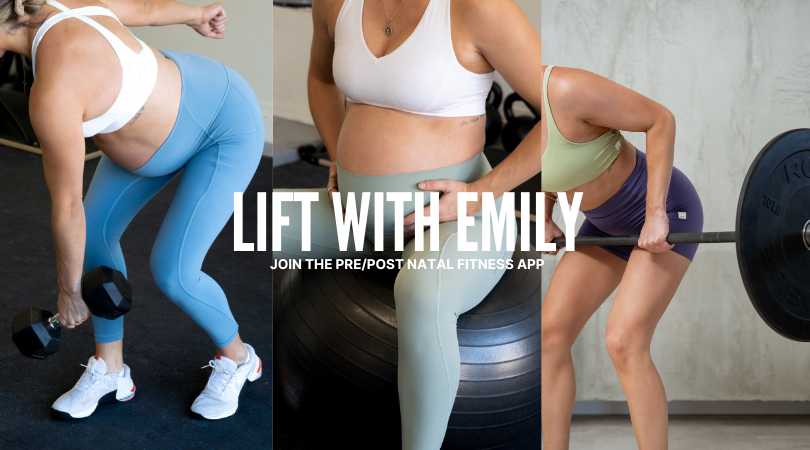
Struggling to feel that core connection again after birth? You’re not alone but the answer isn’t always more core work. Sometimes the key is to zoom out and look at the bigger picture.
Postpartum, your body has gone through huge shifts in alignment, muscle tone, and pressure management. Reconnecting to your core isn’t just about direct ab exercises — it’s about how your whole system works together. And one of the biggest players in that system? Your glutes.
When we rebuild strength postpartum, we have to look beyond isolated muscles and train how they work together — especially in foundational movements like squatting, hinging, lifting, and carrying. That’s where the glutes and core need to work in sync.
Why Glute Strength Matters for Core and Pelvic Floor Recovery
Your glutes aren’t just for aesthetics — they’re crucial for pelvic stability, hip extension, spinal alignment, and functional movement. When they’re weak or not firing efficiently (which is very common postpartum), your core and pelvic floor often try to overcompensate.
That can lead to:
- Core tension or “gripping” (especially in the upper abs)
- Poor pressure management and breath coordination
- Pelvic instability or low back discomfort
- Symptoms like leaking or heaviness due to overworked pelvic floor muscles
Glute strength supports the alignment of your pelvis, which creates a more balanced and responsive core. And when we load movements that integrate glute and core function together, we build strength that translates into daily life — lifting kids, going up stairs, getting back into fitness.
8 Glute + Core Integration Exercises (Postpartum-Friendly)
These movements include a mix of gentle and more strength-based options — all designed to train your core and glutes as a team. Here’s why they matter and what to focus on with each:
1. Hip Hinge with Isometric Band Pull
This variation teaches you how to stabilize your trunk while moving from your hips — a foundational skill postpartum. The isometric band pull encourages upper body engagement and ribcage positioning, making it a full-body stability drill with a deep core connection.
2. Split Squat with Cable Resistance
Adding cable resistance challenges your ability to control the pelvis and spine under load, especially in a single-leg position. It demands both glute strength and deep core stabilization — helping retrain unilateral control and pelvic alignment postpartum.
3. Staggered Hip Thrust with Isometric Block Squeeze
This exercise targets the glutes while incorporating adductor engagement (via the block), which supports pelvic floor and deep core function. The staggered stance introduces asymmetry, training core control and lateral hip stability.
4. Glute Bridge March with Isometric Band Pull
A progression of a standard glute bridge, this variation trains anti-rotational core control. Lifting one foot challenges pelvic stability while the band pull activates the lats and reinforces core engagement through the upper body.
5. DNS Star Plank
This advanced movement builds cross-body coordination and deep trunk stability. It mimics developmental movement patterns, which are powerful tools postpartum for retraining core reflexes and integrated strength.
6. Front Rack Curtsy Lunge
A rotational lunge pattern like this challenges glute control in all three planes of motion — while the front rack load reinforces upright posture and core bracing. It’s a dynamic way to train real-world strength and balance.
7. Copenhagen Plank with Forward Reach
This isometric hold strengthens the adductors and lateral hip while incorporating a reach that activates obliques and deep core muscles. It’s especially helpful for improving hip stability and building pelvic floor support.
8. Supported Single Leg Deadlift
A great way to build unilateral glute strength while training the core to resist rotation. The support helps maintain balance early on while still challenging coordination and pelvic control.
Final Thoughts
Rebuilding core strength postpartum isn’t just about targeting the abs — it’s about creating a system that works together again.
If you’ve been stuck in the cycle of endless core work without feeling stronger, take a step back and zoom out. Your glutes might just be the missing piece.
Looking for more guidance?
If you’re tired of guessing your way through pelvic floor recovery or wondering if your workouts are helping or holding you back…
The Lift with Emily App is built for you.
Whether you’re newly postpartum or months into rebuilding, you’ll get structured, progressive strength training that goes beyond kegels — with intentional programming that supports your core, pelvic floor, and full-body strength.
- Science-backed
- Breath- and load-integrated
- Strength-focused, not fear-based
➡️ Join hundreds of women building real strength from the inside out.
Start your training today →

I’m deeply passionate about helping women feel strong, informed, and confident through every stage of motherhood. You deserve more than just a list of do’s and don’ts or generic modifications. With years of hands-on coaching across all kinds of athletes and clients, I blend real-world experience with specialized pre and postnatal knowledge to create strength programs that go far beyond basic adjustments. This is high-level, accessible training - built for your body, your season, and your goals
EXPLORE MORE POSTS